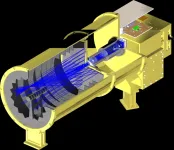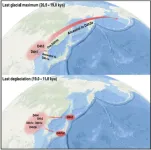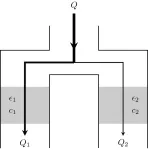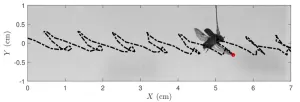(Press-News.org) Scientists from UNSW Sydney with collaborators at Boston University have developed a tool that shows early promise in detecting Parkinson’s disease years before the first symptoms start appearing.
In research published today in the journal ACS Central Science, the researchers described how they used neural networks to analyse biomarkers in patients’ bodily fluids.
The researchers from UNSW School of Chemistry examined blood samples taken from healthy individuals gathered by the Spanish European Prospective Investigation into Cancer and Nutrition (EPIC). Focusing on 39 patients who developed Parkinson’s up to 15 years later, the team ran their machine learning program over datasets containing extensive information about metabolites – the chemical compounds that the body creates when breaking down food, drugs or chemicals.
After comparing these metabolites to those of 39 matched control patients – people in the same study who didn’t go on to develop Parkinson’s – the team were able to identify unique combinations of metabolites that could prevent or potentially be early warning signs for Parkinson’s.
As UNSW researcher Diana Zhang explains, she and Associate Professor W. Alexander Donald developed a machine learning tool called CRANK-MS, which stands for Classification and Ranking Analysis using Neural network generates Knowledge from Mass Spectrometry.
“The most common method of analysing metabolomics data is through statistical approaches,” says Ms Zhang.
“So to figure out which metabolites are more significant for the disease versus control groups, researchers usually look at correlations involving specific molecules.
“But here we take into account that metabolites can have associations with other metabolites – which is where the machine learning comes in. With hundreds to thousands of metabolites, we’ve used computational power to understand what’s going on.”
A/Prof. Donald says that in addition to looking at combinations of metabolites, the researchers used an unedited list of data.
“Typically, researchers using machine learning to examine correlations between metabolites and disease reduce the number of chemical features first, before they feed it into the algorithm,” he says.
“But here we feed all the information into CRANK-MS without any data reduction right at the start. And from that, we can get the model prediction and identify which metabolites are driving the prediction the most, all in one step. It means that if there are metabolites which may potentially have been missed using conventional approaches, we can now pick those up.”
How this could be significant for Parkinson’s Disease
At present, Parkinson’s Disease is diagnosed by observing physical symptoms such as a resting hand tremor. There are no blood or laboratory tests to diagnose non-genetic cases of it. But atypical symptoms such as sleep disorder and apathy can present in people with Parkinson’s decades before the motor symptoms show up. CRANK-MS, therefore, could be used at the first sign of these atypical symptoms to rule in or out, the risk of developing Parkinson’s in the future.
However, A/Prof Donald emphasises that validation studies are needed using much larger cohorts and conducted in multiple parts of the globe before the tool could be used reliably. But in the limited cohort examined for this study, results were promising, with CRANK-MS able to analyse chemicals found in blood to detect Parkinson’s disease with an accuracy of up to 96 per cent.
"This study is interesting at multiple levels,” he says.
“First, the accuracy is very high for predicting Parkinson's disease in advance of clinical diagnosis. Second, this machine learning approach enabled us to identify chemical markers that are the most important in accurately predicting who will develop Parkinson's disease in the future. Third, some of the chemical markers that drive accurate prediction the most have been previously implicated by others to Parkinson's disease in cell-based assays but not in humans."
Food for thought
There were some interesting findings when examining the metabolites of people who went on to develop Parkinson’s in the study.
For example, triterpenoids were found in lower concentrations in the blood of those who later developed Parkinson’s disease compared to those who did not. Triterpenoids is a known neuroprotectant that regulates oxidative stress and is commonly found in foods such as apples, olives, and tomatoes. A future study could examine whether eating these foods could naturally protect against developing Parkinson’s disease.
Also worthy of further exploration was the presence of polyfluorinated alkyl substances (PFAS) in people who went on to develop Parkinson’s, which could be linked to being exposed to industrial chemicals.
“We have evidence to suggest that it is PFAS, but we need more characterisation data to be 100 per cent sure,” says A/Prof Donald.
Freely available to all
CRANK-MS is a tool that is publicly available to any researchers who would like to use machine learning for disease diagnosis using metabolomics data.
“We’ve built the model in such a way that it’s fit for purpose,” says Ms Zhang.
“The application of CRANK-MS to detect Parkinson’s disease is just one example of how AI can improve the way we diagnose and monitor diseases. What’s exciting is that CRANK-MS can be readily applied to other diseases to identify new biomarkers of interest.
“The tool is user-friendly where on average, results can be generated in less than 10 minutes on a conventional laptop.”
END
Scientists develop AI tool to predict Parkinson’s disease onset
2023-05-09
ELSE PRESS RELEASES FROM THIS DATE:
SwRI selected for Phase A study to develop next-generation NOAA coronagraph
2023-05-09
SAN ANTONIO — May 9, 2023 —NASA has selected Southwest Research Institute for a Phase A study to develop SwRI’s Space Weather Solar Coronagraph (SwSCOR) on behalf of the National Oceanic and Atmospheric Administration (NOAA). NOAA’s Space Weather Next Program is charged with providing critical data for its space weather prediction center. SwRI is one of five organizations developing a definition-phase study to produce the next-generation NOAA L1 Series COR instrument to detect and characterize Earth-directed coronal mass ejections (CMEs).
CMEs are huge bursts of coronal plasma threaded with intense magnetic fields ...
Long molecule of RNA essential to our GI tract’s ability to contract and move food along
2023-05-09
AUGUSTA, Ga. (May 9, 2023) – A long molecule of RNA found in abundance in the healthy smooth muscle cells that give our blood vessels strength and flexibility is also essential to the continuous contraction that moves food through our gastrointestinal tract.
Without CARMN, a long, noncoding RNA, which means it doesn’t produce proteins but does help regulate cell activity, the 30-foot-long GI tract doesn’t contract as it should.
That can result in a painful even lethal situation where partially undigested food gets ...
A CRISPR-edited calf shows virus resistance
2023-05-09
A gene-edited calf shows resistance to a common bovine virus. Bovine viral diarrhea virus (BVDV) causes gastrointestinal and respiratory symptoms as well as reproductive failure in cattle around the world. Vaccines against the virus exist but the virus evolves quickly and vaccines are not always fully protective. Aspen Workman and colleagues used the CRISPR/Cas9 system to swap out just six amino acids in the bovine CD46 receptor in one calf. The calf showed a dramatic reduction in susceptibility to the virus and ...
Potential found to counter depression by restoring key brain rhythm
2023-05-09
Led by researchers from NYU Grossman School of Medicine and University of Szeged in Hungary, a new study in mice and rats found that restoring certain signals in a brain region that processes smells countered depression.
Publishing in the journal Neuron online May 9, the study results revolve around nerve cells (neurons), which “fire” – or emit electrical signals – to transmit information. Researchers in recent years discovered that effective communication between brain regions ...
Evidence of Ice Age human migrations from China to the Americas and Japan
2023-05-09
Scientists have used mitochondrial DNA to trace a female lineage from northern coastal China to the Americas. By integrating contemporary and ancient mitochondrial DNA, the team found evidence of at least two migrations: one during the last ice age, and one during the subsequent melting period. Around the same time as the second migration, another branch of the same lineage migrated to Japan, which could explain Paleolithic archeological similarities between the Americas, China, and Japan. The study appears May 9 in the journal Cell Reports.
“The Asian ...
Trends in deaths from falls among adults age 65 or older
2023-05-09
About The Study: Between 1999 and 2020, deaths coded as being caused by falls among adults age 65 or older in the U.S. increased in number and rates for the overall population and for every population subgroup, although the magnitude of the increase varied. However, the relative ranking of the different groups has not changed over time.
Authors: Alexis R. Santos-Lozada, Ph.D., of Pennsylvania State University in University Park, is the corresponding author.
To access the embargoed study: Visit our For The Media website at this link https://media.jamanetwork.com/
(doi:10.1001/jama.2023.3054)
Editor’s ...
Extracting the best flavor from coffee
2023-05-09
WASHINGTON, May 9, 2023 – Espresso coffee is brewed by first grinding roasted coffee beans into grains. Hot water then forces its way through a bed of coffee grains at high pressure, and the soluble content of the coffee grains dissolves into the water (extraction) to produce espresso.
In 2020, researchers found that more finely ground coffee beans brew a weaker espresso. This counterintuitive experimental result makes sense if, for some reason, regions exist within the coffee bed where less or even no coffee is extracted. This uneven extraction becomes more pronounced when coffee is ground more finely.
In Physics of Fluids, from AIP Publishing, ...
Preserving pine forests by understanding beetle flight
2023-05-09
WASHINGTON, May 9, 2023 – The mountain pine beetle is one of the main causes of tree mortality in the pine forests of North America. For example, the insect has killed thousands of acres of pine forest in British Columbia and Alberta, and as a result, the areas are more vulnerable to wildfire. Increased tree mortality has turned Canada’s forests into a large net source of atmospheric carbon dioxide – emitted from the burned or decaying wood of dead trees – rather than a sink.
In Physics of Fluids, by AIP Publishing, researchers from the University of Alberta studied the flight performance of the mountain pine beetle from a fluid mechanics and an entomological perspective. ...
US gun violence: half of people from Chicago witness a shooting by age 40, study suggests
2023-05-09
Study following Chicagoans over a 25-year period suggests over half of the city’s Black and Hispanic population, and a quarter of its White population, have seen a shooting by age 40.
Researchers followed over two thousand people, with 50% of all the study’s participants witnessing a shooting.
Average age when first witnessing a shooting was just 14 years old.
Women only slightly less likely than men to witness shootings, despite men being far more likely to get shot.
Such levels of violence exposure may cause chronic stress and knock-on health implications for populations in Chicago and elsewhere.
A ...
Assessment of medical cannabis and health-related quality of life
2023-05-09
About The Study: In this study, patients using medical cannabis reported improvements in health-related quality of life, which were mostly sustained over time. Adverse events were rarely serious but common, highlighting the need for caution with prescribing medical cannabis.
Authors: Thomas R. Arkell, Ph.D., of the Swinburne University of Technology in Melbourne, Victoria, Australia, is the corresponding author.
To access the embargoed study: Visit our For The Media website at this link https://media.jamanetwork.com/
(doi: ...





